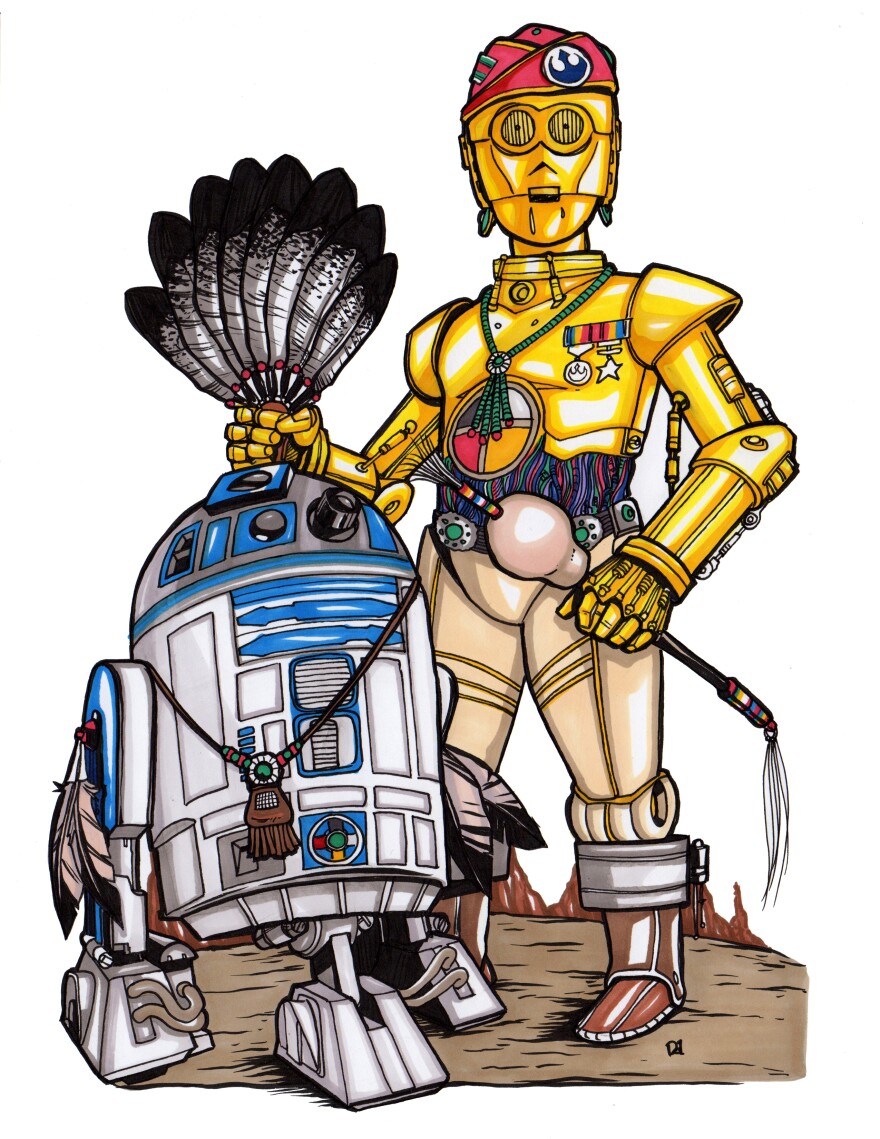This month is the release of the latest “Star Wars” movie. “The Rise of Skywalker” is said to be the final chapter in the original saga, continuing the storylines of rebellion, dark versus light, endurance, and friendship. Those themes have long resonated with “Star Wars” devotees. That is uniquely true among Native American fans. From landscapes to survival skills to philosophy to imperialism, “Star Wars” speaks to the historical experiences of many Indigenous people. An art exhibit that reopens at the Museum of Northern Arizona in Flagstaff Fri, Dec. 20 sheds light on those connections. KNAU’s Ryan Heinsius reports on “The Force Is With Our People,” an all-Native-artist show.
Artist Duane Koyawena is piloting a custom R2-D2 unit in front of the museum. It’s life-size and sounds a lot like the original, but Koyawena painted the exterior in a traditional maroon-and-tan pattern of Hopi pottery.
“When I was thinking about it I was like, wouldn’t it be cool to see an R2 that’s decked out—looks like actually a pottery. So along with that comes the designs, and so the tans and the reddish burn marks from when they fire their pottery,” he says.

But according to Koyawena this R2 unit has substance far beyond its outer beauty.
“R2 in the movies kind of shows a big support or always willing to help get through obstacles in tough times. A lot of elders, or our uncles or friends, always tell us in ceremony, ‘nahongvitah,’ which means to give it your all, or just to be strong and persevere. I feel Hopi R2 kind of fits in that same line,” he says.
Koyawena is one of 25 artists from more than a dozen Southwestern tribes taking part in “The Force Is With Our People.” Curator and ethnographer Tony Thibodeau got the idea for the exhibit during a trip to Indigipop X, the Indigenous Comic-Con in Albuquerque.

“I think there’s clearly some parallels between Native stories—things like the Hero Twins, very prominent story in Navajo culture—parallels between that and ‘Star Wars,’ of course Luke and Leia being basically Hero Twins in that story,” he says.

A glass case in the middle of the exhibit holds tiny wooden Chewbaccas carved in the Navajo style. Nearby stands a storm trooper painted in Apache patterns, and on a sidewall are comic-book illustrations of R2-D2 and C-3PO represented as Navajo Code Talkers.

“We’re trying to get at the question of are there parallels between the ‘Star Wars’ narrative and Native culture that make it resonate with the Native artists and Native communities on the Colorado Plateau in a specific way?” Thibodeau says.
For Navajo artist Ryan Singer the answer is yes.
“I think that’s one of the parallels that Indigenous people have been fighting with and fighting for, and I think they can kind of feel like the rebels fighting the Empire,” Singer says.

Singer paints vivid depictions that overlap life on the reservation with the “Star Wars” universe. Cultural assimilation, inter-generational trauma, and the lasting effects of colonialism are strong in his work. His painting “(De)Colonized Ewok” is a commentary on the forced boarding school experiences of thousands of Native Americans in the 19th and 20th centuries.
“You can use ‘Star Wars’ metaphors or motifs to kind of reel people in to educate them, to let them see what’s happening or to see what happened before in history,” Singer says.
The Force is ultimately about balancing life, making choices, and weighing the negative and positive. That’s what many of these artists are trying to do as they blend cultures, blur lines and fuse traditional, contemporary and futuristic ideas.
After a hiatus "The Force Is With Our People" reopens Fri, Dec. 20 at the Museum of Northern Arizona in Flagstaff.









